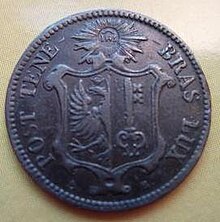
A motto is a sentence or phrase expressing a belief or purpose, or the general motivation or intention of an individual, family, social group, or organisation. Mottos are usually found predominantly in written form, and may stem from long traditions of social foundations, or from significant events, such as a civil war or a revolution. One's motto may be in any language, but Latin has been widely used, especially in the Western world.

Veritas is the name given to the Roman virtue of truthfulness, which was considered one of the main virtues any good Roman should possess. The Greek goddess of truth is Aletheia. The German philosopher Martin Heidegger argues that the truth represented by aletheia is different from that represented by veritas, which is linked to a Roman understanding of rightness and finally to a Nietzschean sense of justice and a will to power.

"In God We Trust" is the official motto of the United States as well as the motto of the U.S. state of Florida, along with the nation of Nicaragua. It was adopted by the U.S. Congress in 1956, replacing E pluribus unum, which had been the de facto motto since the initial design of the Great Seal of the United States.

The coat of arms of Chile dates from 1834 and was designed by the English artist Charles Wood Taylor (1792–1856). It is made up by a figurative background divided in two equal parts: the top one is blue and the bottom, red. A five pointed white star is in the centre of the shield. This background is supported in one side by a condor, the most significant bird of prey from the Andes, and in the other, by a huemul, a mammal endemic to Chile. Both animals wear golden naval crowns symbolising the heroic deeds of the Chilean Navy in the Pacific Ocean.

Plus ultra is a Latin phrase and the national motto of Spain. A reversal of the original phrase non plus ultra, said to have been inscribed as a warning on the Pillars of Hercules at the Strait of Gibraltar, it has metaphorical suggestions of taking risks and striving for excellence. Its original version, the personal motto of the Holy Roman Emperor Charles V, also Duke of Burgundy and King of Spain, was Plus oultre in French. The motto was adopted some decades after Christopher Columbus traveled to Guanahaní.

The O Antiphons are Magnificat antiphons used at Vespers on the last seven days of Advent in Western Christian traditions. They likely date to sixth-century Italy, when Boethius refers to the text in The Consolation of Philosophy. They subsequently became one of the key musical features of the days leading up to Christmas.

The Huguenot Monument in Franschhoek, Western Cape, South Africa, is dedicated to the cultural influences that Huguenots have brought to the Cape Colony after their immigration during the 17th and 18th centuries. These French and Belgian Protestants were fleeing violent religious persecution, especially in Roman Catholic France.
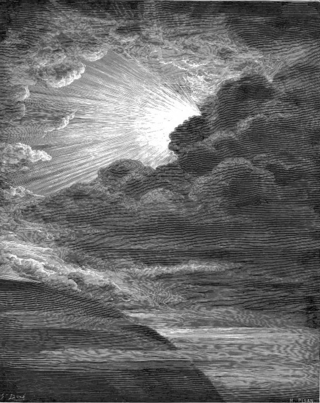
Genesis 1:3 is the third verse of the first chapter in the Book of Genesis. In it God made light by declaration: God said, 'Let there be light,' and there was light. It is a part of the Torah portion known as Bereshit.

Soli Deo gloria is a Latin term for Glory to God alone. It has been used by artists like Johann Sebastian Bach, George Frideric Handel, and Christoph Graupner to signify that the work was produced for the sake of praising God. The phrase has become one of the five solae propounded to summarise the Reformers' basic beliefs during the Protestant Reformation.

The International Monument to the Reformation, usually known as the Reformation Wall, was inaugurated in 1909 in Geneva, Switzerland. Key individuals, events, and documents of the Protestant Reformation are depicted therein in statues and bas-reliefs.
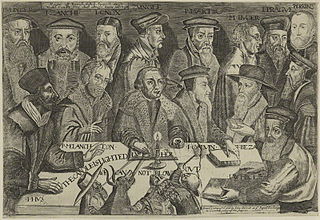
Reformed Christianity originated with the Reformation in Switzerland when Huldrych Zwingli began preaching what would become the first form of the Reformed doctrine in Zürich in 1519.
Lux in Tenebris, in Latin, means "Light in Darkness". "Lux in Tenebris" was also the national motto for the country that was once 'Nyasaland'

Immanuel Tremellius was an Italian Jewish convert to Christianity. He was known as a leading Hebraist and Bible translator.
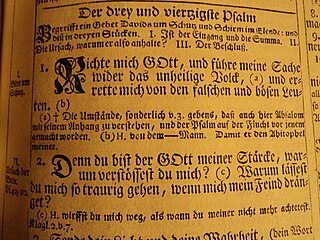
Psalm 43 is the 43rd psalm of the Book of Psalms, known in the English King James Version as "Judge me, O God, and plead my cause against an ungodly nation". In the slightly different numbering system used in the Greek Septuagint and Latin Vulgate translations of the Bible, this psalm is Psalm 42. In Latin, it is known as "Iudica me Deus". It is commonly attributed to the sons of Korah. In the Hebrew Bible, it comes within the second of the five books (divisions) of Psalms, also known as the "Elohistic Psalter" because the word YHWH is rarely used and God is generally referred to as "Elohim".
Colton Hills Community School is a mixed secondary school and sixth form situated in the Goldthorn Park area of Wolverhampton, West Midlands, England.

Théodore Tronchin (1582–1657) was a Genevan Calvinist theologian, controversialist and Hebraist.

Jan Mommaert was the name of two 17th-century printers in Brussels, father and son. Between the dates of their activity, Martine van Straeten operated a printing house under the name Widow of Jan Mommaert.
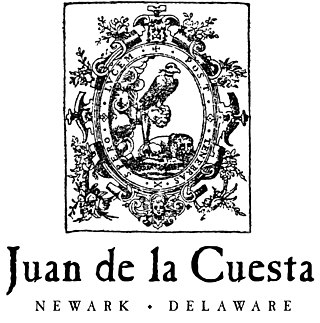
Juan de la Cuesta Hispanic Monographs (Cuesta) is a North American publishing house located in Newark, Delaware. Established in 1978 by Tom Lathrop, Cuesta has published over 400 books dealing with Spanish linguistics and Spanish and Latin American literature from medieval to modern times with a focus on the Spanish Golden Age.
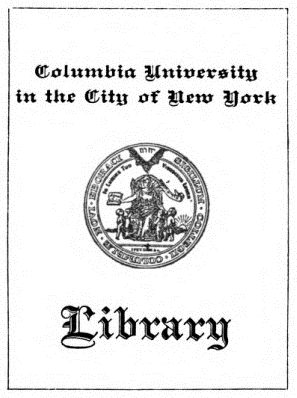
Columbia University represents itself using several symbols, including a university seal and a coat of arms. The seal was first adopted in 1755, shortly after the university's founding, and with few variations continues to be used today. The coat of arms was adopted by the university in 1949. Additionally, the individual schools of Columbia possess their own logos, most of which contain some variant of the King's Crown symbol. Exceptions to this rule include the College of Physicians and Surgeons, which in addition to a logo adopted a variant of the university seal, and the School of General Studies, which inaugurated its own coat of arms in 1950 based on the Columbia arms.

